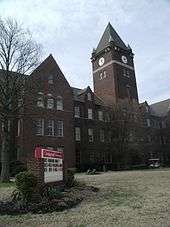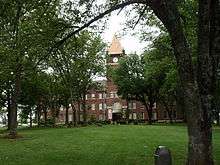Cumberland University
 | |
| Type | Private |
|---|---|
| Established | 1842 |
| President | Paul C. Stumb IV |
| Students | 1,500 |
| Location | Lebanon, Tennessee, U.S. |
| Colors |
Maroon and White[1] |
| Athletics | NAIA – Mid-South |
| Nickname | Phoenix |
| Website |
www |
- For other institutions called "Cumberland College," see Cumberland College. For the school in Williamsburg, Kentucky, see University of the Cumberlands.
Cumberland University is a private university in Lebanon, Tennessee, United States. It was founded in 1842, though the current campus buildings were constructed between 1892 and 1896.[2]
History
_(14778838722).jpg)
The university was founded by the Cumberland Presbyterian Church in 1842 and received its Tennessee State charter in 1843. In 1847 Cumberland Presbyterian church leaders added a law school, the first in Tennessee and the first west of the Appalachian Mountains, and in 1854 a school of theology was begun.
The original building, designed by Philadelphia architect William Strickland, housed schools of art, law and theology. It was burned by the Union Army during the American Civil War.[2]
Following the war, the university's faculty included former Confederate general A. P. Stewart. He taught there during his post-Civil War Union parole.[2]
From its early years, Cumberland University maintained a reputation for high-quality education. The Cumberland School of Law at one time was said to have had more of its alumni elected to Congress than any other in the South.
The American Civil War nearly destroyed Cumberland University. University Hall was burned to the ground when Union forces occupied the campus, a fate common to many Southern institutes of learning. A Cumberland student wrote on a ruined Corinthian column the Latin Resurgam (I will arise). The university thereafter adopted the mythical phoenix bird as its symbol. By 1866, just one year after the war's end, all departments were again operating in various locations in the town of Lebanon. Cumberland University moved to its present campus location in 1892.
The university fell on hard times during the Great Depression, as did most small private colleges. After World War II, Cumberland experienced several changes in sponsorship and programs. In 1946, The Tennessee Baptist Convention assumed control of the school, ending a century of operation by the Cumberland Presbyterian Church.
In 1951, the Tennessee Baptists closed the College of Arts and Sciences and operated only the School of Law. In 1956, the Board of Trust secured an amendment to the Charter and changed Cumberland to a private, independent corporation. The College of the Arts and Sciences was reopened as a two-year junior college, known as Cumberland College of Tennessee. In 1962, the assets of the School of Law were transferred to Howard College now known as Samford University in Birmingham, Alabama.
The Board of Trust expanded the academic programs of the junior college in 1982, returning Cumberland to a four-year, degree institution. It resumed the old name of Cumberland University. Since then, Cumberland has expanded its academic program to include new majors and specialized student-learning opportunities.
Cumberland University believes that a broad education, based in the liberal arts, is the best foundation for a lifetime of learning. Students from every state and from many foreign countries now attend Cumberland. Its alumni include 14 governors, more than 80 members of the United States Congress, two Supreme Court justices, three United States ambassadors, and one United States Secretary of State (Cordell Hull, known as the "father of the United Nations").
Cumberland School of Law
In 1847 Cumberland Presbyterian church leaders added the Cumberland School of Law, the first law school in Tennessee and the first west of the Appalachian Mountains. For many years the law school was located in historic Caruthers Hall, named for Robert Looney Caruthers, a founder of Cumberland University.[2]
The trustees sold the School of Law and its assets in 1962 to what is now Samford University in Birmingham, Alabama. The law school continues to operate there.
Community outreach
Cumberland University gives back to the local community in many ways. Cumberland has a Circle K club, which is affiliated with Kiwanis International.[3] On February 13, 2010, Cumberland University hosted a conference basketball game, and donated half of its gate admissions to Sherry’s Run, a non-profit organization created to benefit people with cancer.[4] Also, the Cumberland University cycling team formed its own chapter of local non-profit organization Ride for Reading.[5]
Athletics

Cumberland University teams, nicknamed athletically as the Phoenix, are part of the National Association of Intercollegiate Athletics (NAIA), primarily competing in the Mid-South Conference. The Phoenix formerly competed in the TranSouth Athletic Conference. Men's sports include baseball, basketball, cross country, football, golf, soccer, tennis and wrestling; while women's sports include basketball, cross country, golf, soccer, softball, tennis and volleyball.
Cumberland football began on October 26, 1894 with a 6–6 tie with Peabody and finished that first year with a 2–1–1 season record. The early days of Cumberland football were very promising. The pinnacle of the early days of CU football was the 1903 season that began with a (6–0) win over Vanderbilt then a (0–6) loss to Sewanee and continued with a five-day road trip with victories over Alabama (44–0) November 14, 1903, LSU (41–0) November 16, 1903, and Tulane (28–0) November 18, 1903. Cumberland would play a postseason game against Coach John Heisman's Clemson team on Thanksgiving Day that ended in an 11–11 tie and a record of 4–1–1 [6] which gave Coach A.L. Phillips and Cumberland University the Championship of the Southern Intercollegiate Athletic Association.[7][8] The 1916 game against Georgia Tech is famous as the most lopsided-scoring game in the history of college football, which was a 0–222 loss for Cumberland University.
Cumberland's baseball program is probably its best-known athletic team, especially those of the 2004, 2010, and 2014 baseball seasons, which won the World Series of the NAIA; the 1995 and 2006 teams were runner-up in this event.
In addition, Cumberland achieved a top-ten finish at the National Collegiate Cycling Association's National Championship, its women's basketball team finished as NAIA National Tournament Runner-Up in 2007, and Cumberland achieved a National Tournament appearance for the No. 17-ranked Men's Tennis Team in 2007. The men's basketball team also earned success in the 2008–2009 basketball season earning another trip to the National Tournament.
Cumberland University's Women's Basketball team won the Mid-South Conference title in 2012–2013 and lost in semi finals of the NAIA national tournament in Frankfort Kentucky
For the 2008 season, CU's football earned a share of the Mid-South Conference West Division.
On August 7, 2013, Cumberland University was granted provisional membership into the Great Midwest Athletic Conference (G-MAC) after a vote of league presidents, paving the way for the University to apply to the NCAA for admittance into Division II in February 2014.[9] Cumberland's application to join Division II was denied in 2014.[10]
On January 4, 2016, Cumberland University changed the nickname of its athletic program from "Bulldogs" to "Phoenix", stating that, "For more than 150 years, the Phoenix has personified the spirit of Cumberland University."[11]
Other
The main building on campus was featured in Taylor Swift's music video Love Story.[12]
Presidents
- Franceway Ranna Cossitt, 1842 – 1844
- Thomas C. Anderson, 1844 – 1866
- Benjamin W. McDonnold, 1866 – 1873
- Nathan Green, Jr., 1873 – 1902
- David Earle Mitchell, 1902 – 1906
- Nathan Green, Jr. (Acting), 1906 – 1909
- Winstead Paine Bone, 1909 – 1914
- Samuel Andrew Coile, 1914 – 1916
- Homer Allin Hill (Acting), 1916 – 1917
- Edward Powell Childs, 1917 – 1920
- Andrew Blake Buchanan (Acting), 1920 – 1922
- John Royal Harris, 1922 – 1926
- Ernest Looney Stockton, 1926 – 1941
- Laban Lacy Rice, 1941 – 1946
- Edwin Smith Preston, 1946 – 1950
- W. Edwin Richardson, 1950 – 1952
- Sam B. Gilreath, 1952 – 1956
- Charles B. Havens, 1956 – 1958
- Ernest Looney Stockton Jr., 1958 – 1983
- Robert N. Clement, 1983 – 1988
- M. Walker Buckalew, 1988 – 1991
- J. Thomas Mills, 1991 – 1992
- Ray C. Phillips, 1992 – 1995
- Clair Martin, 1995 – 2000
- Charlene Kozy, 2000 – 2004
- Harvill C. Eaton, 2004 – 2015
- Paul C. Stumb IV, 2015 – present
Notable alumni

The school's alumni include more than eight congressmen and thirty college presidents.
- Howell Edmunds Jackson, Associate Justice of the United States Supreme Court, 1893–1895
- Thomas P. Gore, United States Senator from Oklahoma, 1907–1921; 1931–1937
- Horace Harmon Lurton, Associate Justice of the United States Supreme Court, 1910–1914
- George Huddleston, U.S. Representative from Alabama, 1915–1937
- Cordell Hull, Secretary of State under President Franklin Delano Roosevelt from 1933 to 1944.
- Frank G. Clement, Governor of Tennessee, 1954–1959; 1963–1967
- David R. Ray, Medal of Honor Recipient for his heroic actions during the Vietnam War
- Oren Harris, U.S. Representative from Arkansas, 1953–1966; thereafter a U.S. District Judge based in El Dorado
- Maecenas Eason Benton, U.S. Representative from Missouri, 1897–1905, and father of famous painter, Thomas Hart Benton.
- Wright Patman, U.S. Representative from Texas, 1929–1976
- George E. Allen, head coach of the 1916 football team that lost 0–222 to Georgia Tech, later an advisor to President Harry Truman
- Cale Young Rice, playwright and poet.
- Laban Lacy Rice, noted educator and writer, former president of Cumberland University.
- Thomas G. Abernethy, U.S. Representative from Mississippi, 1943–1973
- Morgan M. Moulder, U.S. Representative from Missouri, 1948–1962
- Theodore M. Brantley 1881 – longest-serving Chief Justice of the Montana Supreme Court, serving for 23 years (1899–1922)
- Jeff Davis (Arkansas governor), Democratic United States Senator from Arkansas and the 20th Governor of the U.S. state of Arkansas[13]
- Brady Gentry – U.S. Representative from Texas 1953–1957
- John T. Watkins – U.S. Representative for Louisiana's 4th congressional district, 1905 to 1921
- Lynn Kyle Watkins - Louisiana circuit court judge and brother of John T. Watkins
References
- ↑ Cumberland University Graphic Standards Manual (PDF). Retrieved 2016-06-12.
- 1 2 3 4 "Lebanon, Tennessee: A Tour of Our City" (PDF). Lebanon/Wilson County Chamber of Commerce. Archived from the original (PDF) on June 15, 2007. Retrieved February 5, 2007.
- ↑ http://www.cumberland.edu/campuslife/studentorgs
- ↑ http://www.sherrysrun.org/archives/621
- ↑ http://www.rideforreading.com/?page_id=133
- ↑ http://www.jhowell.net/cf/scores/Cumberland.htm#1903
- ↑ "Champions of the South regardless of conference affiliation".
- ↑ Langum, David J. From Maverick to Mainstream: Cumberland School of Law, 1847–1997. p. 95.
- ↑ http://www.cumberland.edu/news/2013/08/07/cu-becomes-provisional-member-of-gmac.660334
- ↑ "Division II Admits its 300th Member". ncaa.org. Retrieved 28 September 2015.
- ↑ "CU athletics launches new nickname". The Wilson Post. Retrieved 4 January 2016.
- ↑ TaylorSwiftVEVO (2009-06-16), Taylor Swift - Love Story, retrieved 2016-08-02
- ↑ "Arkansas Governor Jefferson Davis". National Governors Association. Retrieved August 17, 2012.
External links
Coordinates: 36°12′14″N 86°17′56″W / 36.204°N 86.299°W